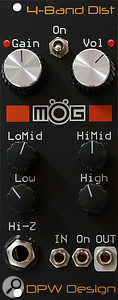Described as a four-band preamp, overdrive and distortion module, the MÖG D‑2 puts guitar pedal power at the heart of your Eurorack. Further crossover is evidenced by twin inputs; joining the expected mini-jack is a quarter-inch Hi-Z input, enabling you to process guitar, bass or line-level instruments (such as synths) within the modular environment.
 MÖG D‑2. Size: 10HP. Current: +12V 25mA, -12V 15mA.Operation is simplicity itself: connect your source, flip the switch then set the levels for each of the bands, adjusting overall gain and output to taste. With CV control only of its on/off status, the D‑2 is about playing, listening and tweaking those well-spaced knobs. As a useful reference, the Volume LED lights when the output breaches 6V, while a Gain LED ensures you don’t overdrive the input and therefore lose the benefits that lie in store.
MÖG D‑2. Size: 10HP. Current: +12V 25mA, -12V 15mA.Operation is simplicity itself: connect your source, flip the switch then set the levels for each of the bands, adjusting overall gain and output to taste. With CV control only of its on/off status, the D‑2 is about playing, listening and tweaking those well-spaced knobs. As a useful reference, the Volume LED lights when the output breaches 6V, while a Gain LED ensures you don’t overdrive the input and therefore lose the benefits that lie in store.
From the first moments, your ears tell you this is no ordinary distortion. The old-school analogue design does a credible impression of a quartet of tube amps in parallel, with Gain acting as the overall drive control. By dividing the distortion into Low, LoMid, HiMid and High circuits, the D‑2 offers a rare level of fine-tuning, rendering other distortion effects crude and unsubtle in comparison.
The Low boost is a suitably monstrous tool for toughening up kicks or beefing up basses. Next, the LoMid covers a warm, full distortion suitable for adding body to practically anything. In contrast, the HiMid adds zap or shape; I found small to moderate amounts of it ideal for giving analogue synths a little extra presence. Finally, the High range adds bite and clarity wherever it’s needed — even to sources such as muddy kicks or dull basses.
The D‑2 has more sweet spots than a dalmatian dipped in sugar; once experienced, it will probably find its way into pretty much everything you do.
In use, this module can supply a mildly dirty four-band EQ with a slightly compressed, fat quality. Simply set the Gain low then compensate with the Volume control. As you start to crank it up, you selectively unleash a distortion that is both musical and refined — not terms typically applied to distortion effects. Perhaps because of its guitar pedal inspiration, the D‑2 is highly responsive to dynamics, providing boost without mud and mush. Lastly, I found it a great companion for other, more pristine modules, eg. it worked wonders in the send/return loop of a 4MS Dual Looping Delay.
As I mentioned earlier, the only CV control is an on/off switching CV input, which activates the effect on receipt of 1V or more. The input easily copes with rates between DC and audio, the results being an irregular but pleasing variety of glitching. By feeding a Yamaha Reface piano into the quarter-inch input and modulating the on/off status with a wide-ranging VCO, my piano began spitting out everything from edgy tremolo to pseudo-ringmod-type noises. Incidentally, use of the Hi‑Z input doesn’t disable the regular mini-jack, which is helpful.
While some users might wish for CV control of each band, there’s something to be said for at least one module in your case that is simple, hands-on and just sounds wonderful. The D‑2 has more sweet spots than a dalmatian dipped in sugar; once experienced, it will probably find its way into pretty much everything you do. Given it also serves as a preamp to bring your guitar, bass or synth up to Eurorack levels, I have no hesitation in giving it an unqualified thumbs up.
